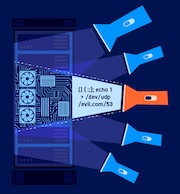ProfessionalCommunity Edition
Filtering the WebSockets history with Bambdas
-
Last updated: March 31, 2025
-
Read time: 3 Minutes
You can apply Java-based Bambdas to create powerful custom filters for your WebSockets history. You can do this in two ways:
-
Load existing Bambdas - Load Bambdas from your Bambda library.
-
Create new Bambdas - Write and apply Bambdas directly in the WebSockets history filter window.
Related pages
- For more information on how to manage your Bambdas, see Managing Bambdas in your Bambda library.
- For more information on how to add Bambdas to your library for use across Burp, see Importing Bambdas into your Bambda library.
Keyboard shortcuts
To speed up your workflow when creating or loading Bambdas, you can use the following keyboard shortcuts:
Save -
Ctrl + SorCmd + SSave as -
Ctrl + Shift + SorCmd + Shift + SCreate new Bambda -
Ctrl + NorCmd + NLoad recent Bambda -
Ctrl + OorCmd + O
Loading Bambdas from your library
You can load and apply Bambdas that are stored in your library to filter the WebSockets history.
To load a Bambda from your library:
-
In Proxy > WebSockets history, click the filter bar to open the WebSockets history filter window.
-
In the WebSockets history filter window, click Bambda mode.
-
Click Load.
-
Select a recent Bambda from the list.
-
If the Bambda you want to load isn't in the list, click View all to view all Bambdas stored in your library.
- Select a Bambda.
- Click Load.
-
[Optional] If required, edit the Bambda:
Make your changes.
Click Apply to compile and test the Bambda. Fix any errors shown in the Compilation errors panel. For more information, see Troubleshooting Bambdas.
-
Save your changes:
To overwrite the existing Bambda, click Save to library > Save.
To save a new version, click Save to library > Save as.
Click Apply & close.
Burp compiles your Bambda and applies it to every item already logged in your WebSockets history, as well as any future WebSocket traffic generated in this project.
Creating custom Bambdas
You can write your own Bambdas directly in the WebSockets history filter window, using built-in templates or from a blank definition.
Note
Before you begin writing, we recommend exploring our Bambdas GitHub repository. There may be an existing Bambda that meets your needs or provides inspiration for creating your own.
Converting filter settings to Bambdas
You can convert filter settings to a Bambda as a starting point for further customization:
-
In Proxy > WebSockets history, click the filter bar to open the WebSockets history filter window.
Make changes to the filter settings as necessary.
At the bottom of the WebSocket history filter window, click Convert to Bambda.
Your filter is converted into a Bambda, enabling you to customize it further using Java.
Creating your Bambda
Two objects of the Montoya API are available to help you write your Bambda:
ProxyWebSocketMessageUtilities
To create a Bambda to filter your WebSockets history:
-
In Proxy > WebSockets history, click the filter bar to open the WebSockets history filter window.
-
In the WebSockets history filter window, click Bambda mode.
-
If you want to create your Bambda from a built-in template, select New > From template. Select a template from the list, then click Create using this template.
-
Write your Bambda using Java.
-
Click Apply to compile and test the Bambda. Fix any errors shown in the Compilation errors panel. For more information, see Troubleshooting Bambdas.
-
[Optional] Click Save to library > Save. The Bambda is saved to your Bambda library for future use across Burp.
-
Click Apply & close.
Burp compiles your Bambda and applies it to every item already logged in your WebSockets history, as well as any future WebSockets traffic generated in this project.
Warning
Using slow running or resource-intensive Bambdas can slow down Burp. Write your Bambda carefully to minimize performance impact.
Example Bambda
This example Bambda filters the WebSockets history to show only items that meet the following criteria:
The message must be sent from the server.
The message payload length must be greater than
300characters.
In this example, our Bambda is:
return message.payload().length() > 300 && message.direction() == Direction.SERVER_TO_CLIENT;
Related pages
- To get feedback, showcase your work, and connect with other Bambda developers, share your Bambda on our PortSwigger Discord #bambdas channel.
- To share your Bambdas with the community, add them to our ever-growing Bambdas GitHub repository. For more information, see Submitting Bambdas to our GitHub repository.


